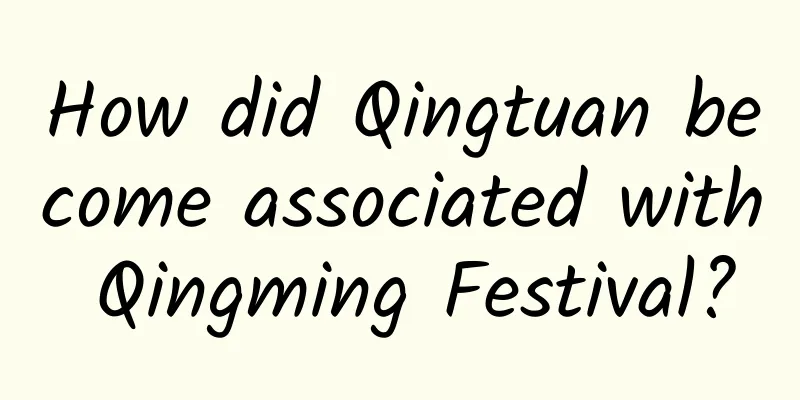How did Qingtuan become associated with Qingming Festival?

|
The following article comes from Bowu, author Bugua The first time I ate Qingtuan was during the Qingming Festival in Zhejiang. Before that, I had already heard of the fame of Jiangnan Qingtuan, so when I saw the round, plump, emerald green, smooth and attractive jade-like Qingtuan in the local pastry shop, I immediately bought some to try. (Copyrighted image from the gallery, no permission to reprint) Unfortunately, I spit it out after taking a bite... Too sweet! This is simply a giant green dumpling. I don’t like sweetness very much, maybe the green dumpling is just the right sweetness for the locals, but it’s beyond my tolerance. So, my first impression of the green dumpling wiped out my desire to continue exploring it. Fortunately, my friends in Hangzhou and Shaoxing gave me homemade Qingtuan, which are salty, soft, and have a grassy aroma. The green glutinous rice flour skin is filled with bamboo shoots, pickled mustard greens, and minced meat. It is much better than the sweet Qingtuan with red bean paste filling, so it saved me from my disappointment with Qingtuan. The "transformed" Qingtuan is called "Aijiao", "Qingjiao" and "Qingmingguo" by the locals. (Copyrighted image from the gallery, no permission to reprint) Why do we eat Qingtuan during Qingming Festival? Eating Qingtuan around the Qingming Festival is a unique food custom in the Jiangnan region. During the Qingming Festival, Jiangnan people also like to bring Qingtuan with them to offer sacrifices in front of the graves. In other words, this traditional snack with a strong seasonality "wrapped" both food culture and sacrificial culture. The "Qixiu Leigao" written by a Hangzhou native in the Ming Dynasty should be the earliest existing ancient book that records Qingtuan: “ "In the barbarian land, people offered sacrifices to gods with human heads. When Zhuge Liang conquered Meng Huo, he ordered bread and meat to be used as human heads for sacrifice, which were called barbarian heads. Now, it has been corrupted to steamed buns. In ancient times, people picked tung and poplar leaves to dye rice green during the Cold Food Festival to offer sacrifices, in order to replenish yang energy. Now, it has been corrupted to blue and white dumplings, which is the same meaning." ” Although this statement may seem to make people lose their appetite, it points out the reason why Qingtuan is dyed green, and also shows that at that time, "blue and white dumplings" had been widely used as a regular food for Cold Food Festival sacrifices in the Hangzhou area. The Cold Food Festival is the origin of the current Qingming Festival custom of tomb sweeping and ancestor worship. Qingming was originally just a solar term, and it was a happy day for the whole family to go out, enjoy the spring, and get rid of the old and welcome the new; the two days before Qingming were called the Cold Food Festival, which was the first major festival in ancient times. During the Cold Food Festival, the ancients banned fireworks and ate cold food. The predecessor of Qingtuan was one of the mainstream cold foods. Because the Cold Food Festival and the Qingming Festival are so close, the two festivals gradually merged into one, and the essence of the Cold Food Festival, "sacrifice", was integrated into the Qingming Festival, and the cold food of the Cold Food Festival also became the seasonal food of the Qingming Festival. But it seems that only the Qingtuan in the Jiangnan region has been carried forward and firmly tied to the Qingming Festival? According to descriptions in many ancient books, "green grass is used as juice and flour to make cakes, the color of which is like jasper", "flour is dyed green with wheat juice", "green balls are made with rice flour and mugwort juice", and "rice flour is kneaded with mugwort to make balls". The authentic green balls should be made with green juice of plants and glutinous rice flour, which determines the strong seasonality of green balls. Because the temperature rises slowly around the Qingming Festival and the rain nourishes the grass, the grass wakes up, sprouts, and grows branches and leaves. The branches and leaves at this time are tender and soft, with a pleasant smell and are most suitable for eating. The green rice balls made with them have the best taste. Qingtuan is often dyed with mugwort The "green" in Qingtuan generally comes from mugwort, a perennial herb of the genus Artemisia in the Asteraceae family and its closely related species. This type of plant occupies a pivotal position in ancient Chinese folk life, and has formed a "mugwort culture" with a long history. The earliest extant collection of poetry in my country, The Book of Songs, includes more than 300 ballads composed by civilian literati from the early Western Zhou Dynasty to the middle of the Spring and Autumn Period (11th to 6th century BC). Among them, mugwort is mentioned, such as "That girl picking mugwort, a day without seeing her feels like three years." (The Book of Songs, Wang Feng, Picking Ge) It means "That girl picking mugwort, a day without seeing her feels like three years!" This shows that the ancients not only recognized and used this plant early on, but also placed beautiful emotions on it. Mugwort, also known as mugwort, white wormwood, ice platform, medical grass, moxibustion grass, Qi Ai, May Ai, mugwort, yellow grass... These various Chinese names come from all over the world, indicating that this plant is widely distributed and is common, useful and loved in the life of the Chinese nation. (Copyrighted image from the gallery, no permission to reprint) From the perspective of modern botany, the mugwort mentioned by the ancients and passed down orally in the local area and its many aliases do not all refer to the same plant, but they all refer to a type of chrysanthemum with white hairs on the back of the leaves, wider leaf lobes at the bottom of the plant and a strong smell. They share a plant "surname" - Artemisia. Today, the two Chinese names of mugwort or mugwort refer specifically to the plant of the Asteraceae family, whose scientific name is Artemisia argyi. It should be the most well-known member of the Artemisia genus. Even if you have not been treated (abused) by moxibustion, you must have heard of the legend of moxibustion. In addition, most people, especially those in the Jiangnan region, have close contact with mugwort when eating qingtuan or hanging a handful of dry grass on the door to drive away evil spirits... In fact, if you are interested, we can easily see mugwort. It grows vigorously in the wilderness of low and medium altitudes, on the roadsides and rivers of rural fields, and in the green spaces of cities and towns. It sprouts and leaves in spring, and blooms and bears fruit from July to October. During the Qingming Festival, the branches of mugwort are soft and the leaves are tender, with a light and palatable taste. During the Dragon Boat Festival, the branches are old and the leaves are withered, and the taste is strong and insect repellent. As a member of the chrysanthemum family, mugwort flowers are also inflorescences formed by countless small flowers gathered in a certain order, that is, capitula. The capitula of Artemisia are very small and plain, usually spherical or ellipsoidal, with a diameter of only a few millimeters. You can imagine how small the individual flowers that make up the inflorescence are. Yes, you are not mistaken. What you think of as a single flower at first glance is actually countless flowers! The picture shows the flowers of Artemisia argyi. The red circle in the picture is the head inflorescence, which is composed of dozens of small flowers. It takes a lot of energy to create a beautiful flower that can attract bees and butterflies. The smart Artemisia uses wind pollination instead, using the cost of self-beautification to produce more minimalist flowers, more stamens, and more pollen to complete the reproduction task to the greatest extent. (Image source: handwiki.org) Compared to the unremarkable flowers, Artemisia plants represented by mugwort have a more famous feature - think about it, what is your first impression when you mention mugwort? Does mugwort emit a unique smell? Yes, Artemisia plants all contain a variety of volatile compounds, the most famous of which is the anti-malarial drug "artemisinin". To put it bluntly, artemisinin comes from Artemisia annua, not Artemisia annua. Everyone has a different sense of smell, and it is often difficult to describe it objectively. There may even be completely opposite subjective evaluations. For example, Artemisia annua is called "fragrant wormwood" by some, "stinky wormwood", "bitter wormwood" or "fragrant bitter grass" by others. Whatever you call it, just be happy. By the way, I don’t like the taste of Chrysanthemum chrysanthemum either. I will be angry with anyone who uses Chrysanthemum chrysanthemum in hot pot! ! Other blue-dyed plants In addition to mugwort, plants such as artemisia selengensis, amaranth, mud cabbage, and brome are also used to make green balls. They can easily produce green juice, have strong coloring power, are widely distributed, and always appear in people's vision as roadside wild flowers and field weeds. They are just less popular and their taste is not as obvious as mugwort. Gnaphalium, also known as Gnaphalium, is also a kind of chrysanthemum, but it belongs to the genus Gnaphalium. As a Chaoshan native, I have never heard of "Qingtuan" in my hometown, but if the green-skinned Gnaphalium cake made with Gnaphalium is also called Ci Ke Kue, it can be considered as Qingtuan, then I have eaten "Qingtuan" since I was a child. The edible part is mainly the tender stems. Gnaphalium (Image source: wiki) Malan, I was not familiar with this vegetable when I lived in Guangdong before, and I remember that my mother had never bought it. It is a kind of chrysanthemum, belonging to the genus Aster. Fujian and Guangdong call it field chrysanthemum, roadside chrysanthemum, Hubei, Sichuan, Guizhou, Guangxi call it fish loach string, loach string, loach vegetable, Yunnan is called 蓑衣莲. Its head inflorescence is yellow in the center and light purple on the edge. The young leaves are often used as spring vegetables, commonly known as "Malan head". Mud mustard is another kind of chrysanthemum, a member of the genus Mud mustard. It grows all over the country except Xinjiang and Tibet. The stem is upright and tall, with long inflorescence branches on the upper part. The flowers are purple-red. When it blooms, the overall shape is much more dazzling than the above three compatriots in the Asteraceae family. However, people eat the tender leaves before the flower buds appear, so if you are not careful, you will miss it. I admire the ability of people who love wild vegetables to discover it. Mud Cabbage (Image source: libproject.edu) Brome is a plant of the genus Brome of the Poaceae family. It is a valuable forage grass in natural grasslands and artificial pastures. It is widely distributed in the forest edges of hillsides, roadsides in wilderness, and floodplain wetlands across the country. In ancient times, it was a common plant material for making green balls, and its usage was the same as that of mugwort. I don't know how it tastes, and I haven't eaten it. The grass family to which wheat, rice, corn, sorghum and other grains belong is a major contributor to grains. Except for bamboo, the edible parts are almost all seeds. So the way to use brome is quite creative. Wheat Sparrow (Image source: tnipc.org) But! But! Most people use mugwort and other ingredients to make their own green rice dumplings, which are often weeds picked from the wild, from fields, or from roadsides. As authentic "natural" ingredients, they have not been artificially selected or tested for safety, so they should be eaten in small amounts and not be too greedy. In addition, we do not recommend that you go to the wild to find wild vegetables. If you lack experience, you are likely to mistake them and eat them by mistake. We recommend that you go to the vegetable market or supermarket to buy green vegetables. at last, I wish you all a happy holiday and plenty of green rice dumplings! Don't eat too much, you will get fat!! Written by | Bugua WeChat Editor | Ah She Shuang Source: Museum |
<<: What are some things you thought were disadvantages that are actually advantages?
Recommend
rua Can I pet a tiger if I'm allergic to cats? Tiger: Are you polite?
What is it like to encounter a tiger just when yo...
Former Baidu employee reveals the secrets of knowledge search marketing: Get over 10,000 accurate exposures per week at 0 cost!
Search engine promotion is keyword-based marketin...
More than 20 packages were rejected by the Apple Store in one day. What has the App Store done in the past two months!
Introduction The apps that were rejected this tim...
What should I do if I receive a call and find out that I am a close contact? Practical tips →
"Infected Person 218" is popular! After...
Li Ziqi returns, bringing "lacquerware" to the fore! What is the charm of this intangible cultural heritage?
Recently, the well-known internet celebrity "...
iPhone 6 released today, said to have changed, scalpers are raising the price to make money
The seller showed the reporter an iPhone 6 protot...
Anhui Self-study Network SEO Optimization Training Case
We made this website for a client. You can see th...
What is the difference between a 20 yuan shampoo and a 200 yuan shampoo?
People often complain: Why do I spend money on a ...
iOS channel first release rules and contact list
91 Assistant 1. First Release Form During the ini...
It’s the beginning of autumn! Who put on weight last year and hasn’t lost it this year?
What do you think of when you mention the beginni...
Internet online channel operation implementation plan!
Section 1. Implementation Planning and Operations...
Take you to appreciate the top ten programming algorithms that are dominating the world
[[121078]] It’s hard to overstate how important a...
User operation and promotion of full network marketing
In the past, when companies were doing product ma...
Surpassing QQ: WeChat has become the most frequently used tool for online fraud crimes
[[282844]] The recently released "Special Re...
China Automobile Dealers Association: Retail sales ranking of various automobile brands in February 2022
According to the latest retail sales data from th...









